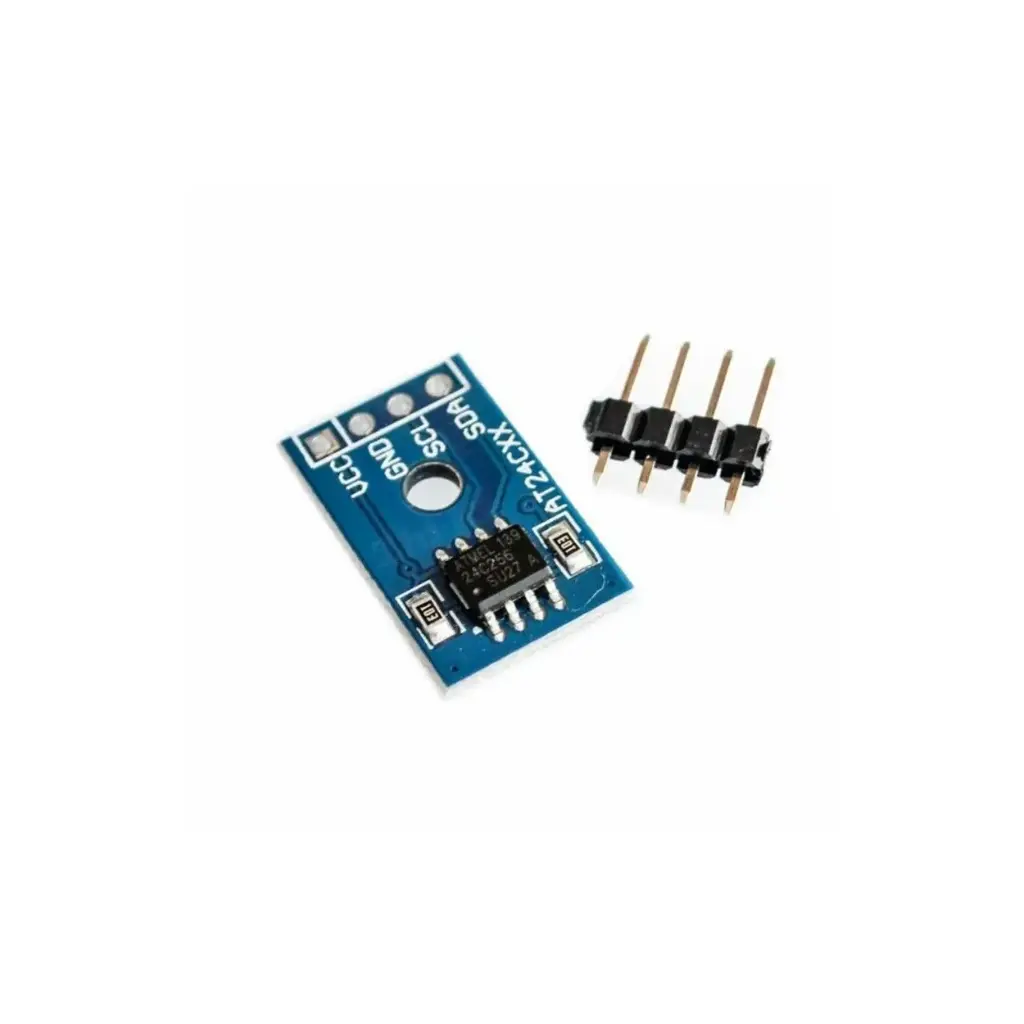Features:
- Large Storage Capacity: 32,768 bytes (256Kb) organized as 32,768 x 8 bits.
- Flexible Voltage Operation: Supports both low and standard voltage operations from 1.8V to 5.5V.
- Multiple Module Support: Adjustable I2C address via three jumpers enables up to 8 EEPROMs on the same I2C bus.
- Hardware Write Protection: Includes a write-protect pin to prevent accidental data overwrite.
- High Endurance: 1,000,000 write cycles and 40 years of data retention.
- Efficient Write Cycle: Self-timed 5ms max page write for 64 bytes (partial writes allowed).
Specifications:
- Chip: AT24C256
- Capacity: 256Kb (32,768 bytes)
- Organization: 32,768 x 8-bit
- Operating Voltage: 1.8V–5.5V
- I2C Speed:
- 1 MHz @ 5V
- 400 kHz @ 2.7V or 2.5V
- 100 kHz @ 1.8V
- Write Cycle Time: 5 ms max (self-timed)
- Write Endurance: 1 million cycles
- Data Retention: 40 years
- Interface: I2C (2-wire)
- Dimensions: 6.00 x 6.00 x 1.00 cm
Pinout:
- VCC: Power supply (1.8V–5.5V)
- GND: Ground
- SCL: I2C Clock line
- SDA: I2C Data line
- WP: Write Protect (connect to GND to enable writing)
Wiring with Arduino:
Connect the EEPROM to Arduino using the I2C interface:
- VCC → 5V on Arduino
- GND → GND on Arduino
- SCL → A5 (for Uno/Nano)
- SDA → A4 (for Uno/Nano)
Example Arduino Code:
Make sure to install the AT24C256 library before using this code.
// I2C library
#include "AT24C256.h"
// Create EEPROM object
AT24C256 eeprom = AT24C256();
int val = 24; // Value to store
int Add = 0; // Memory address
void setup() {
Serial.begin(9600);
while (!Serial) {
; // Wait for Serial to connect (needed for native USB boards)
}
}
void loop() {
// Write value to EEPROM
Serial.println("Writing of " + (String)val + " on " + (String)Add);
eeprom.write(val, Add);
// Read back and display the value
Serial.println(eeprom.read(Add));
// Stop further execution
while(1);
}
Applications:
- Data logging and sensor value storage
- Settings backup for wireless systems
- Offline configuration memory
- EEPROM-based security keys
Features:
- Large Storage Capacity: 32,768 bytes (256Kb) organized as 32,768 x 8 bits.
- Flexible Voltage Operation: Supports both low and standard voltage operations from 1.8V to 5.5V.
- Multiple Module Support: Adjustable I2C address via three jumpers enables up to 8 EEPROMs on the same I2C bus.
- Hardware Write Protection: Includes a write-protect pin to prevent accidental data overwrite.
- High Endurance: 1,000,000 write cycles and 40 years of data retention.
- Efficient Write Cycle: Self-timed 5ms max page write for 64 bytes (partial writes allowed).
Specifications:
- Chip: AT24C256
- Capacity: 256Kb (32,768 bytes)
- Organization: 32,768 x 8-bit
- Operating Voltage: 1.8V–5.5V
- I2C Speed:
- 1 MHz @ 5V
- 400 kHz @ 2.7V or 2.5V
- 100 kHz @ 1.8V
- Write Cycle Time: 5 ms max (self-timed)
- Write Endurance: 1 million cycles
- Data Retention: 40 years
- Interface: I2C (2-wire)
- Dimensions: 6.00 x 6.00 x 1.00 cm
Pinout:
- VCC: Power supply (1.8V–5.5V)
- GND: Ground
- SCL: I2C Clock line
- SDA: I2C Data line
- WP: Write Protect (connect to GND to enable writing)
Wiring with Arduino:
Connect the EEPROM to Arduino using the I2C interface:
- VCC → 5V on Arduino
- GND → GND on Arduino
- SCL → A5 (for Uno/Nano)
- SDA → A4 (for Uno/Nano)
Example Arduino Code:
Make sure to install the AT24C256 library before using this code.
// I2C library
#include "AT24C256.h"
// Create EEPROM object
AT24C256 eeprom = AT24C256();
int val = 24; // Value to store
int Add = 0; // Memory address
void setup() {
Serial.begin(9600);
while (!Serial) {
; // Wait for Serial to connect (needed for native USB boards)
}
}
void loop() {
// Write value to EEPROM
Serial.println("Writing of " + (String)val + " on " + (String)Add);
eeprom.write(val, Add);
// Read back and display the value
Serial.println(eeprom.read(Add));
// Stop further execution
while(1);
}
Applications:
- Data logging and sensor value storage
- Settings backup for wireless systems
- Offline configuration memory
- EEPROM-based security keys
